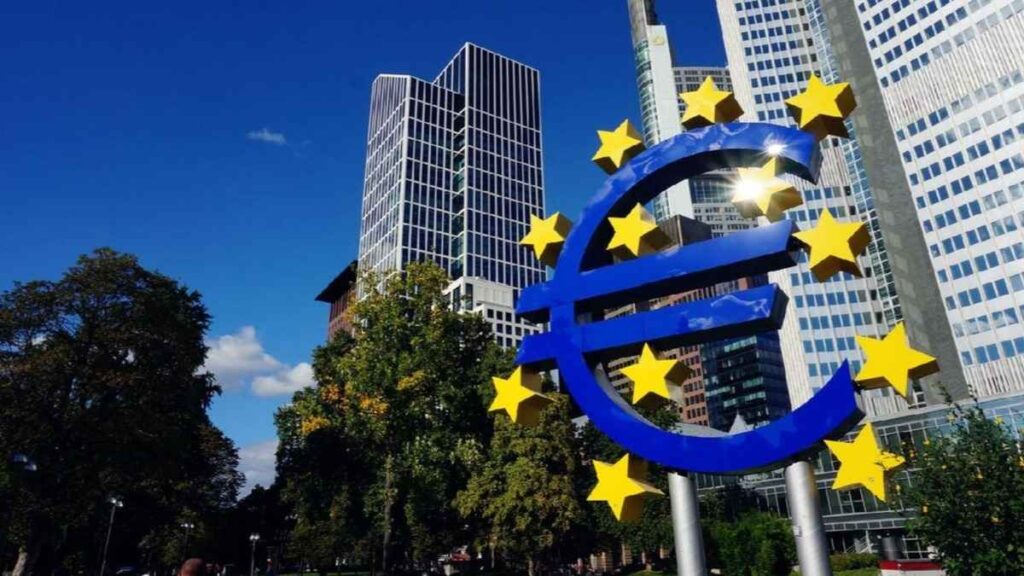The European Central Bank (ECB) made a bold move on Thursday, slashing interest rates for the first time since 2019. This decision signals a potential turning point in the fight against inflation that has gripped the eurozone for the past year.
Inflation Cools, Prompting a Shift in Strategy
We cut our key interest rates by 0.25 percentage points.
— European Central Bank (@ecb) June 6, 2024
Keeping interest rates high for nine months has helped push down inflation.
It is now appropriate to moderate the degree of monetary policy restriction.
Read our monetary policy decisions https://t.co/AaaLd3hGEB pic.twitter.com/dTTYKg7itm
Previously, the ECB had adopted an aggressive policy of raising interest rates to combat soaring inflation. This strategy, while effective in curbing price hikes, also risked stifling economic growth. However, with inflation finally dipping closer to the ECB’s target of 2%, the bank felt it was time to adjust its approach.
A Pioneering Move: ECB Leads the Way
The ECB’s rate cut places them at the forefront of a potential global shift in central bank policy. While the Federal Reserve in the United States remains cautious, Europe’s central bank has taken a proactive stance in stimulating the economy. This decision could pave the way for other central banks to follow suit, as inflation shows signs of easing across the globe.
A Look Back: Battling Inflation’s Surge
In late 2022, the eurozone witnessed a surge in inflation, with average prices exceeding 10%. This phenomenon stemmed from a confluence of factors, including rising energy costs, supply chain disruptions caused by the pandemic, and the war in Ukraine. To combat this inflationary pressure, the ECB embarked on a series of unprecedented rate hikes. The deposit rate, which influences borrowing costs across the eurozone, was raised from a record low of negative-0.5% in July 2022 to a peak of 4% in September 2023.
Success on the Horizon: Inflation Retreats
The European Central Bank’s strategy appears to be paying off. Inflation in the eurozone has steadily declined, reaching 2.6% in May. This significant drop is largely attributed to a decrease in energy prices and a stabilization of food prices, which had previously skyrocketed to over 12% a year ago.
Stock Market Reacts: A Mixed Bag
The European stock market displayed a knee-jerk reaction to the ECB’s announcement. Initially, Europe’s benchmark stock index surged to an all-time high, anticipating the economic benefits of lower interest rates. However, some gains were subsequently erased as investors digested the ECB’s cautious stance on future rate cuts.
The Delicate Balancing Act: Growth vs. Inflation
The ECB faces a delicate balancing act in the coming months. While lower interest rates could stimulate economic growth, they also carry the risk of reigniting inflationary pressures. The central bank is committed to cutting rates in a measured way to prevent the economy from slipping below its inflation target. This careful approach is reflected in the ECB’s staff forecast, which predicts eurozone growth of 0.9% for 2024, a significant revision upwards from the 0.6% projection made three months ago.
A Measured Approach for the Future
The European Central Bank’s decision to cut interest rates signifies a crucial turning point in the eurozone’s economic journey. By prioritizing both inflation control and economic growth, the central bank is navigating a complex situation with a calculated approach. This move could have significant ramifications not only for Europe but also for the global economy as a central banks around the world grapple with similar challenges.
Who Owns the European Central Bank?
The European Central Bank (ECB) isn’t owned by a single entity or government. Instead, it functions with a unique ownership structure:
- Shareholders: All 27 central banks of the European Union member states act as shareholders of the ECB.
- Capital Contribution: Each central bank contributes a specific amount of money to the ECB’s capital stock, currently valued at €10.8 billion (as of January 1, 2024).
This structure ensures the ECB remains independent of any single national influence and reflects the collaborative nature of the European Union.
How Many Countries are in the European Central Bank?
There’s a slight distinction to clarify here. The European Central Bank itself isn’t a collection of countries, but rather a central bank institution. However, it operates within a broader system:
- European System of Central Banks (ESCB): This overarching system encompasses the ECB and the national central banks of all 27 EU member states. The ECB acts as the central bank for the eurozone, the 20 EU countries that use the euro currency.
How Much Money Does the European Central Bank Have?
The ECB’s capital stock, as mentioned earlier, stands at €10.8 billion (as of January 1, 2024). This represents the financial contributions made by the national central banks of EU member states.
It’s important to note that the ECB’s influence extends beyond its capital. It manages monetary policy for the eurozone, impacting the money supply and interest rates, which indirectly affects the overall financial landscape.
Who is the Head of the ECB?
The ECB is led by a president who oversees its operations and represents the bank in international forums. Currently, Christine Lagarde holds the position of ECB President.
The decision-making body within the European Central Bank is the Governing Council. This council comprises the six members of the Executive Board, including the President, and the governors of the central banks of the eurozone countries.
Also Read: Nvidia Stock Soaring: AI Powerhouse or Pre-Crash Bubble? Decoding the Post-Split Frenzy

